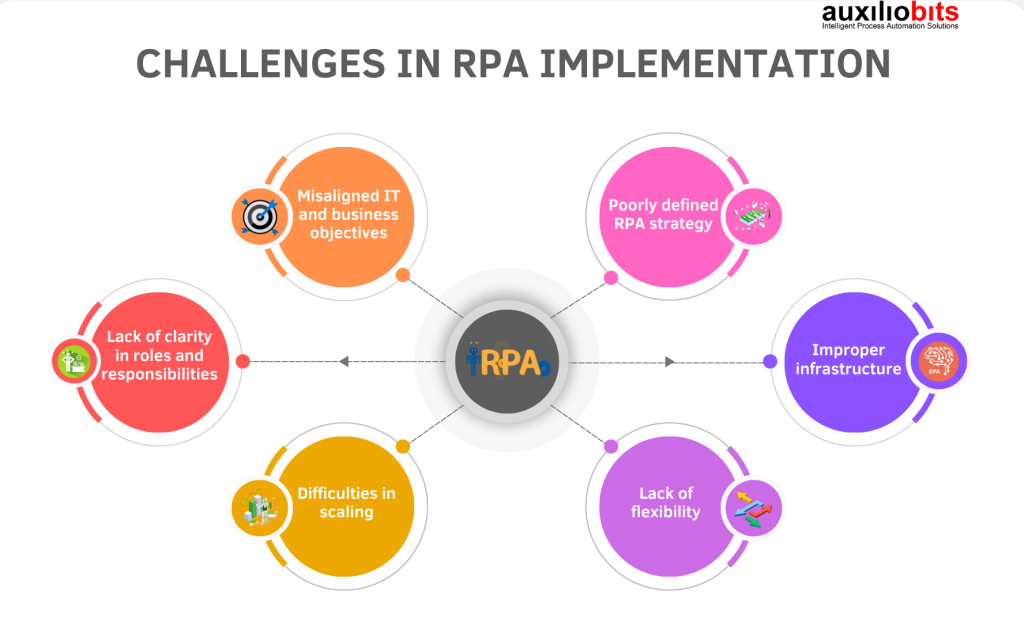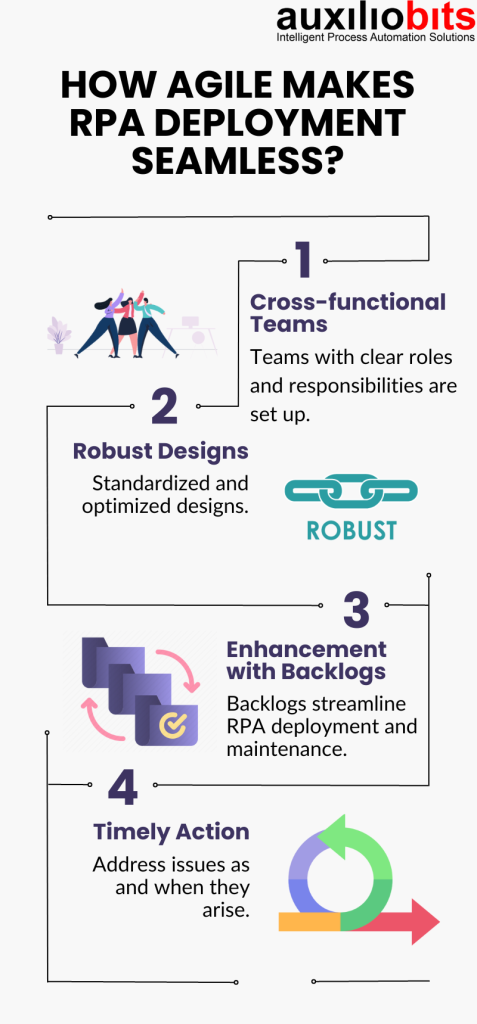
Key takeways
- Most businesses are deploying RPA because of the benefits it offers.
- Many businesses are unable to reap the benefits of RPA despite investing in the best tools.
- An agile approach to RPA deployment overcomes the shortcomings of the traditional methods.
- Agile makes the RPA more flexible and helps businesses scale.
Most businesses are now aware of the benefits that RPA (Robotic Process Automation) offers. Many have already adopted it and many others are keen to adopt it. According to an RPA survey by Deloitte Global, 53% of respondents have already started their RPA journey and 19% intend to in the next two years. (Source: Flobotics.io)
- Why Businesses are adopting RPA?
- RPA Benefits for Businesses
- Challenges in RPA Implementation
- What is Agile?
- Stages in Waterfall Project Management
- Difference between Agile and Waterfall Methodologies
- Role of Agile in RPA Deployment
- Why do Businesses Need an Agile Approach for RPA Deployment?
- How Agile Makes RPA Deployment Seamless?
- Benefits of Agile Methodologies in RPA Deployment
Why Businesses are Adopting RPA?
RPA is a technology where bots automate rule-based processes. Bots perform these tasks independently without human intervention. Various administrative and non-administrative tasks such as invoice processing, billing, manufacturing, etc., can be automated across domains.
RPA Benefits for Businesses:
Minimizes Errors
When bots take over manual tasks, manual errors get eliminated. This enhances the outcomes. Accurate results help businesses enhance their customer experience.
Enhances Speed
Bots perform various tasks much faster than humans do. This reduces delays in processes, time to market, etc.
Relieves Humans
RPA relieves the staff from mundane tasks so that they can utilize their time for more skilled tasks. Automation helps reduce fatigue and burnout among employees who spend hours performing monotonous tasks.
Boosts Productivity
When the speed and accuracy of processes improve, and the staff works on more skilled tasks, the productivity of the organization improves.
Facilitates Better Decision-Making
Bots leverage data to provide insights for better decision-making. AI (Artificial intelligence) works with RPA and analyzes unstructured data which helps make forecasts that facilitate better planning.
Enhances Customer Satisfaction
The ultimate objective of any enterprise is to make its buyers happy. RPA helps businesses enhance customer satisfaction by improving efficiency. It also enables businesses to understand their customers and provide them with products/services tailored to their needs. AI bots work 24/7 to address customer queries.
Optimizes Costs
RPA helps businesses reduce the cost of labor and other operating costs.
However, not all businesses are experiencing the promised benefits and are left wondering if RPA was the right decision for their business!
Various reasons are cited why RPA does not take off as desired. A recent survey reveals that 69% of RPA projects fail because of complexity (Source:Cloud4c.com)
Many businesses are not successful in implementation because of poor execution.
Challenges in RPA Implementation
- Lack of clarity in roles and responsibilities
- Misaligned IT and business objectives
- Poorly defined RPA strategy
- Improper infrastructure
- Lack of flexibility
- Difficulties in scaling, and more!
Fortunately, there is one solution to overcome all these challenges and more to help businesses deploy RPA seamlessly!

The solution is Adopting Agile Methodologies for RPA Implementation!
Let’s delve into how agile works for RPA deployment!
What is Agile?
The agile methodology entails breaking a project into phases or sprints and following an iterative process to complete the project. Various teams are assigned specific tasks. They collaborate to follow a cycle of planning, executing, and evaluating. Project requirements, plans, outcomes, etc., are continually evaluated throughout the project lifecycle, and changes are made where required.
Agile is an iterative project management methodology that entails continuous releases based on customer feedback.
Before agile most software projects followed the waterfall model where a set sequence is followed with minimal deviation.
A typical Waterfall Project Management Process goes through the following stages:
- Defining requirements.
- Designing
- Development
- Acceptance Testing
- Maintenance
This method works perfectly when there is clarity in the requirements and knowledge of technological tools.
Agile differs from Waterfall in the following aspects:
- It focuses on people and interactions instead of processes and tools.
- Working software is prioritized over complete documentation.
- Agile emphasizes a collaborative approach with customers instead of a contractual one.
Unlike the waterfall model which follows a plan, agile responds to change. Agile proved to be a game changer by enabling businesses to adapt to changes.
Agile helps businesses to respond to fluctuations in customer demands thereby boosting customer experience.
Role of Agile in RPA Deployment
A typical RPA implementation process goes through the following stages:
Step 1: Identifying processes and workflows to be automated.
Step 2: Develop the roadmap of RPA deployment including timelines, budget, resources required, and expected outcomes.
Step 3: Choosing the best RPA tool.
Step 4: Designing automation workflows which entail mapping out steps in each process and developing automation workflows to replicate them.
Traditionally this process is completed using the waterfall method. However, the waterfall method is not the best option for RPA because of its inherent limitations.
There are several instances when RPA bots may not produce the expected outcomes due to a lack of understanding of the tool. Therefore, you may need to tweak the software for desired results. However, the waterfall approach has no room for flexibility or iteration. Hence, the software developed may not serve the purpose for which it was designed.
In the waterfall model, robots are not deployed during the planning, analysis, and design phases. Waterfall models launch the robotic deliverables only during the implementation phase. Therefore, businesses miss out on valuable feedback loops during different stages of project management.
A typical RPA implementation process is completed in a few weeks from inception to production. Traditional waterfall models cannot keep pace with this speed. Agile methodology with its collaborative approach works as a powerful RPA enabler.
Businesses find it difficult to scale because of the rigidity of the waterfall approach. RPA is not able to adapt to the growing needs of the business. Besides, the waterfall model is incapable of supporting complex systems because of the difficulties in ensuring regulatory compliance.
Why do Businesses Need an Agile Approach for RPA Deployment?
RPA is a technological disruption that entails software development, implementation, and coordinated change management. It requires the integration of different automation tools that have been procured.
RPA bots take over several processes and replace humans. This impacts different departments and roles within the organization. Therefore, robust change management is essential.
Bots touch various systems and user interfaces. If the bot is not able to respond to changes, the entire automation system can fail.
Many organizations find that the RPA projects need to be redesigned from time to time because they cannot address any unforeseen problems. An agile approach makes bots capable of responding to various changes.
Agile Automation Process:
- The entire process is broken into phases.
- Each component is analyzed in parallel at a specific time.
- Development commences after the analysis is completed.
- Each component is tested after development.
- After all, components are developed, they are integrated and tested.
- Product releases are scheduled by coordinating with affected parts of the business.
How Agile Makes RPA Deployment Seamless?
1. Cross-functional Teams
The chief objective of RPA is to enhance the efficiency of repetitive, low-skill tasks. Traditionally only IT was responsible for implementing RPA.
However, agile methodologies require cross-functional teams that work collaboratively with each other to arrive at solutions. Therefore, the organization needs to set up teams with clear roles and responsibilities. These teams work towards their specific goals and collaborate for final outcomes. This helps align IT and business.
2. Robust Designs
In an agile approach business processes are designed and optimized before the start of development. Businesses can standardize and optimize complex and multi-layered processes comprehensively. They can also integrate those processes with larger business objectives and regulatory controls.
3. Enhancement with Backlogs
Backlogs help businesses break complex processes into smaller work items and prioritize them. Backlogs also streamline bot maintenance. When changes occur in the bot environment, backlogs smother new items to deliver value and innovation.
4. Timely Action
In the waterfall model, the software development progresses according to a pre-defined sequence. Hence, if anything is amiss, it is addressed at the end of the project. Fixing issues entails a lot of rework and cost implications. On the other hand, in the agile approach, project planning is done in short sprints which facilitates the re-organization of work to address any issues as and when they arise.

Benefits of Agile Methodologies in RPA Deployment
- Since agile follows an iterative process, it makes RPA more flexible and adaptable to change. Once the RPA tool is deployed, additional features can be appended if required.
- Agile helps a business scale RPA and Intelligent Automation across the enterprise by providing a governance framework.
- By adopting an agile approach, businesses can implement RPA seamlessly. This is because they can leverage reusable components, workflows, standards, guidelines, etc.
- Agile methodology facilitates the intervention of the Subject Matter Expert (SME) throughout the RPA lifecycle. This is required throughout the development process especially if the process is not described or some logic is missing. SME serves as a point of contact for clarifications until acceptance testing is complete.
- In the waterfall model, testing is done after the entire project is complete. So, fixing bugs and errors in the entire software is a complicated process. However, in the agile approach, the delivery is broken into phases that can be tested individually and fixed.
If you are considering deploying RPA in your organization, make sure to use an agile approach. This will help you overcome various bottlenecks and reap the benefits of RPA. It is recommended that you seek the help of experts in the field for RPA implementation.
Auxiliobits is a leading name in the field of automation! We provide automation solutions for different domains. Our team is knowledgeable about the nuances of automation and has relevant experience in the field. We help our clients in selecting the best tools and deploying them seamlessly. Our experts leverage the best strategies to make your automation journey hassle-free!
Connect with our team NOW for the best automation solution for your enterprise!
Stay Tuned for more on automation!





